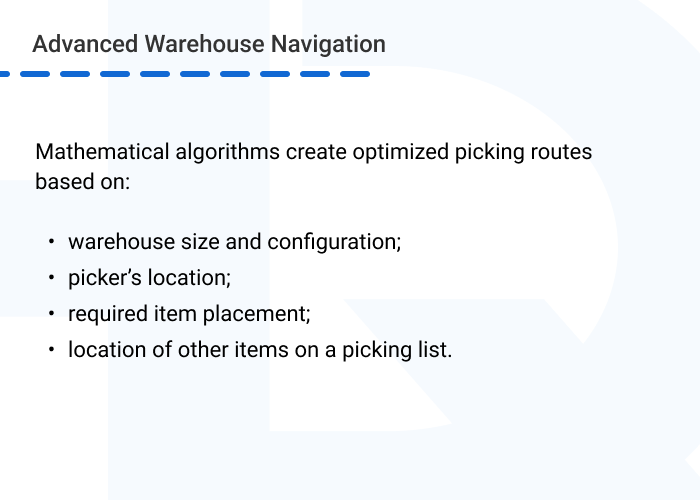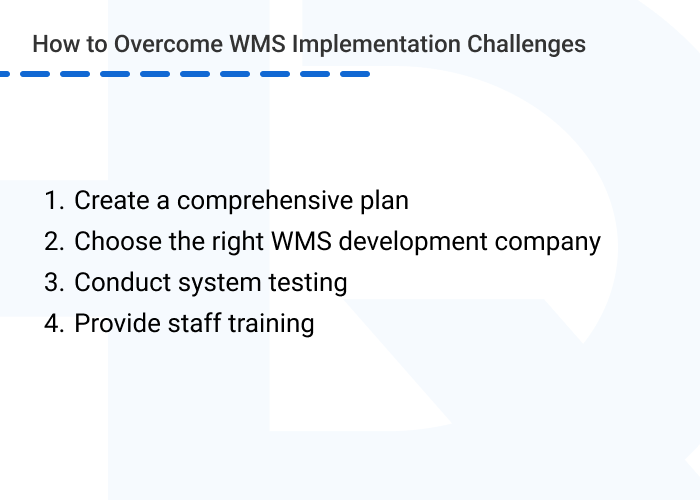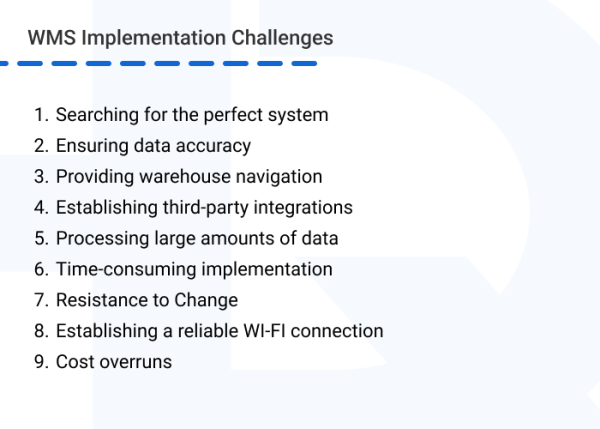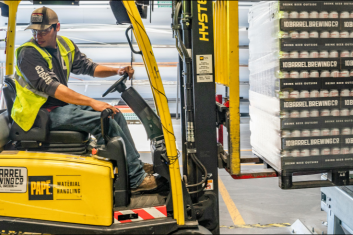What are the Challenges of Implementing a WMS?
In a competitive market, with growing demand for quick and accurate order fulfillment, you may discover that your employees are struggling to complete orders as quickly as required. Or you may find yourself out of stock on in-demand goods because of inventory control issues.
To handle warehouse operations more accurately and effectively, you may decide to implement a Warehouse Management System (WMS). But to ensure the system doesn’t become a burden and actually maximizes its business value, you need to be familiar with some common problems of WMS implementation so you can prevent them in advance.
Why Implement a WMS?
A Warehouse Management System (WMS) helps you automate and streamline your warehouse operations, from the time goods enter the warehouse until they leave. It improves inventory management and customer service and optimizes your supply chain.
A WMS offers numerous benefits, including improved accuracy in data and order fulfillment, accelerated picking and packing processes, optimized storage, and reduced labor costs. Also, a WMS can help you identify areas where productivity can be improved and provide detailed reports on warehouse performance and trends.
However, to benefit from a WMS, you have to overcome several system implementation and warehouse automation challenges, described below.
What are the Challenges of Implementing a WMS?
Because incorporating a WMS in your business involves many steps and the effort of many people, issues are bound to come up. But knowing what you’re likely to deal with can help you resolve some common problems of a WMS before they arise. Let’s take a closer look at those challenges.
1. Searching for the perfect system
In trying to find perfect software, especially among the ready-made types, remember no one size fits all. Your business is unique. That’s why you’ll still need to customize the selected WMS to adapt it to your organization. So, you have two options: create a custom WMS system from scratch, or choose a ready-made one with further customization.
With custom software, you have a better chance of getting a system that meets all your demands. You decide which features are necessary and can tailor your system during the development process. But the more features required, the higher the cost and the longer the development time, which may not be feasible for every business.
If you have a limited budget or you’re a relatively small organization that doesn’t need a complex system, your best choice is a ready-made WMS. Then, you should pay attention to finding the right implementation partner who can customize a solution for you, e.g. ensure specific integrations or add new features.
The partner could be an IT team provided by your WMS supplier or a reliable outsourcing vendor. The main thing is to find specialists with extensive experience in implementing WMS systems who can address your business needs and deal with warehouse management challenges.
2. Ensuring data accuracy
Despite the well-established process of receiving and shipping goods, human error is an inevitable hazard. As a result, data in a WMS system may not correspond to the actual quantity of items in stock. This negatively impacts your ability to fulfill client orders, as shortages may result in back orders and shipping delays, while excess quantity wastes storage space.
That’s why it’s important to ensure constant inventory reconciliation by auditing the warehouse. Here, another challenge arises, as it’s time-consuming to provide constant physical verification.
To facilitate warehouse audits, for one of our clients we’ve developed a WMS feature that allows workers to audit only certain goods according to specific parameters, using a mobile app. The WMS generates a daily list of items to be counted according to set triggers, such as cost, expiration date, material, etc. These triggers are very flexible and can be easily modified. Then, according to the list, a picker can count goods and make adjustments in the WMS. With such a feature, you can be confident the system is providing correct data and doesn’t cause errors in other warehouse operations.
Need to develop a custom WMS to boost warehouse operations? We’re ready to help!HQSoftware has a team of skilled professionals ready to tackle the project. Let’s talk!
Anna Halias
Business Development Manager
Moreover, having correct data in the system enables you to procure products in a timely fashion. To make it even smarter, you can implement predictive analytics that forecast demand based on historical and more specific variables such as holidays, seasons, etc. In this way, you can meet customer demand while reducing inventory costs.
3. Providing warehouse navigation
An important goal of a WMS system is to increase labor efficiency by providing warehouse navigation. By using RFID and barcode reading technologies, the location of goods is recorded in the WMS, making it much easier for workers to find the items needed.
But it’s not enough to know where the goods are. If your warehouse is very large or, for example, the same items are stored in different parts of a warehouse, workers may take longer to collect an order. To speed up this process, your WMS can incorporate mathematical algorithms that build optimal routes to goods based on the picker’s location, placement of a required item and other items from the picking lists, and warehouse configuration.

This way, workers can quickly find the required goods with minimal effort, which leads to faster picking and packing processes.
4. Establishing third-party integrations
To have up-to-date information about your suppliers’ capabilities and quickly create shipment orders, you need to connect to their inventory systems. However, each supplier may have its own non-standardized system, which requires a specific connection to your WMS. This can create integration issues due to incompatible software versions or data formats.
The same goes for integrations with your crucial internal systems like ERP or accounting software, as well as external platforms like Shopify. To ensure a smooth integration process, you need to involve skilled integration specialists with extensive experience, and perform thorough testing.
While working with clients’ projects, our team has faced these common problems of WMS implementation very often. We have worked with many different platforms and know how to deal with typical pitfalls to ensure smooth third-party integrations.
5. Processing large amounts of data
As your business expands, you’ll encounter new suppliers, acquire new customers, and increase the number of goods in stock, which leads to constant growth in an already large volume of data. Your WMS must be able to handle all that information smoothly. For example, if the system receives multiple customer requests simultaneously, it must process them quickly to prevent losses.
Igor Kunovskiy
Lead Software Engineer
at HQSoftwareThe main WMS database is constantly under heavy load because of the large amount of data. To ensure its smooth operation, you can benefit from constant system audits, implementation of new architectural solutions, and hardware analysis.
This is a completely technical challenge that requires engineering skills and an understanding of the system. Contact us to learn more about how we’ve assisted our clients with warehouse management challenges.
6. Time-consuming implementation
As implementing a WMS system involves customization, data migration, testing, and user training, it can be time-consuming. You might find yourself wondering about how you can speed up implementation to get the first results as quickly as possible—for example, by not bothering to clean up the data before migration or reducing the time spent testing the system. But then you risk having to spend all the time you saved fixing errors during operation, which can significantly impact warehouse productivity.
So, allow enough time to incorporate your system fully. On average, it takes around 6 months for a system to go live and another 2-3 months to get the first positive outcomes. Also, try to launch the system outside peak periods, when the load on a warehouse is the lowest, to avoid putting additional pressure on employees. Overall, investing time and effort in a careful and thorough implementation process can pay off in the long run.
7. Resistance to Change
Implementing a completely new and complex system can be uncomfortable for your employees. Some may struggle with significant changes to their daily tasks, while others may be resistant as they don’t understand the value of a new system. This can affect productivity and efficiency and ultimately delay the successful implementation of a WMS.
However, by involving employees in the planning process and addressing their concerns and questions, you can minimize resistance. Communication is key, so you should clearly explain how a new system can help workers perform their duties more effectively.
Also, be sure to conduct a series of comprehensive training sessions. This will help employees gain the skills they need to easily operate a system and increase their productivity.
8. Establishing a reliable WI-FI connection
During daily operations, some workers may be moving around the warehouse and using a WMS system on the go. For the system to work correctly and efficiently, especially with a cloud-based one, you need a stable Internet connection in every part of a warehouse. Large warehouses most often implement multiple WI-FI points, so employees must be able to move between them without disrupting the system so as not to lose important data.
But even if you’re confident in your network access, consider enabling your software to run offline for a while, saving all new data and updating it as soon as the Internet connection is available.
9. Cost overruns
During WMS implementation, budget overruns can occur due to:
- poor project planning;
- lack of experience in implementing a WMS;
- choice of unreliable implementation partner;
- unexpected changes in requirements;
- technical issues; and so on.
The best approach to control implementation costs is to create a realistic implementation plan with a viable timeline and budget. You need to conduct regular status meetings with the team to assess progress, identify potential issues and risks, and adjust the plan where necessary. In addition, it’s essential to perform extensive testing before launch to identify and fix bugs that can be costly to resolve once the system is operational.
Strategies to Overcome WMS Implementation Challenges
Although the challenges described above may seem overwhelming, there are several WMS implementation best practices, which can help you decrease their impact or even eliminate some of them.

- Create a WMS implementation plan. It establishes specific goals and objectives, timelines, and the resources required for a successful launch. So, you and your team can better understand the implementation process, make informed decisions, and address any challenges of warehouse management that may arise.
- Choose the right partner for WMS creation. For custom WMS development, pay attention to the company’s industry experience and projects, find out if the company has worked with similar-sized organizations, and ask whether the company has experience integrating with platforms that are crucial to your business.
- Conduct system testing. The testing ensures that the system can handle your unique business needs, including peak seasonal demands, and helps identify any errors or glitches, reducing the risk of costly downtime.
- Provide staff training. It’s necessary to overcome employees’ resistance to change and teach them how to use a WMS to gain maximum productivity.
Discuss With an Expert
As you can see, many issues can keep you from using a new WMS to its fullest potential. The most common challenges of warehouse management system implementation include:
- customizing a WMS system to fit your needs;
- ensuring the accuracy of data;
- optimizing warehouse navigation;
- connecting a WMS with required third-party platforms;
- processing a large amount of data without latency;
- overcoming psychological resistance to change;
- providing an Internet connection for all warehouse sites;
- staying within budget.
With 21+ years in the market, we at HQSoftware have helped our clients overcome many of these challenges by leveraging the skills and experience of our team. So, we’re ready to put our expertise to work to save your organization from costly mistakes, boost warehouse productivity, reduce costs, and increase customer satisfaction. Drop us a line to learn more about our competencies and book a free consultation.

Head of Production
To ensure the outstanding quality of HQSoftware’s solutions and services, I took the position of Head of Production and manager of the Quality Assurance department. Turn to me with any questions regarding our tech expertise.
Related Posts
View All
We are open to seeing your business needs and determining the best solution. Complete this form, and receive a free personalized proposal from your dedicated manager.

Sergei Vardomatski
Founder








